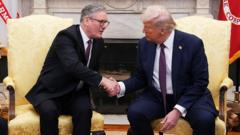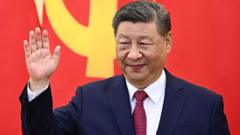The increase in Treasury yields marks a significant shift in investor sentiment as U.S. tariffs threaten the stability of government bonds, previously seen as the epitome of safety in turbulent times.
Tariff Turmoil: U.S. Bond Market Faces Unprecedented Volatility

Tariff Turmoil: U.S. Bond Market Faces Unprecedented Volatility
Amidst escalating trade tensions, U.S. Treasury yields rise sharply, indicating investor distress and fears over the future of American financial stability.
The financial landscape has been rocked this week as the U.S. bond market experiences unforeseen volatility, driven by the far-reaching implications of President Trump’s escalating tariff policies. The yield on the 10-year Treasury bond—a crucial gauge for both corporate and consumer borrowing—had seen a dramatic rise, climbing to around 4.5% from less than 4% just one week prior.
Treasuries, historically regarded as the bedrock of financial security, are now under scrutiny, reflecting deepening investor unease. This week’s fluctuations are not merely a footnote but rather a signal of shifting perceptions regarding U.S. assets, with the current political climate exacerbating concerns over economic stability.
The 0.1 percentage-point spike on Friday is representative of a trend that has raised alarms about the fragility of what was once deemed an unshakeable market. The implications are wide-reaching; consumers with mortgages and car loans will soon feel the impact, as their interest rates are tightly linked to the 10-year yield.
As Treasuries, typically viewed as safe havens during stock market turbulence, face unprecedented peril, market analysts warn of the potential consequences of sustained tariff disputes, emphasizing the urgent need for reevaluating America’s position in the global financial system.






















